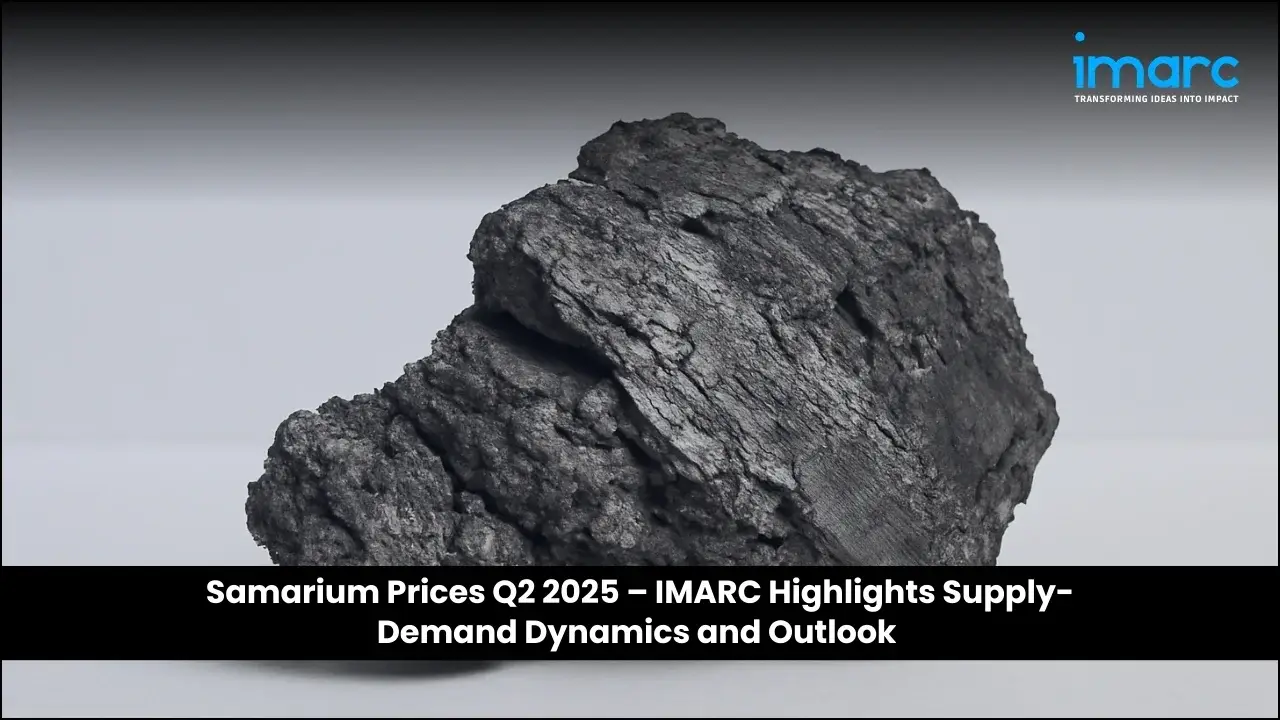Samarium Prices Q2 2025 – IMARC Highlights Supply-Demand Dynamics and Outlook
09-Sep-2025
The global samarium market continues to evolve amid supply constraints, strategic procurement, and rising sectoral demand. According to IMARC Group’s latest publication, Samarium Price Trend, Index and Forecast Data Report 2025 Edition, that provides updated insights for Q2 2025, highlights dynamic pricing trends across major regions, shaped by regulatory shifts, import dependencies, and sector-specific demand in defense, electronics, renewable energy, and semiconductor industries. Key markets contributing to these developments include North America, Asia Pacific, and Europe, reflecting the interplay of domestic production capacities, international trade dynamics, and strategic stockpiling behavior among downstream manufacturers.
Q2 2025 Samarium Prices:
- USA: USD 13.1/Kg
- China: USD 10.8/Kg
- United Kingdom: USD 17.7/Kg
- Russia: USD 15.3/Kg
- South Korea: USD 16.4/Kg
.webp)
To access real-time prices Request Sample
The current fly samarium prices, reflecting strong demand from defense, clean energy, electronics, and semiconductor sectors, underscore the material’s critical role in high-performance applications and contribute to a stable or rising global price trend.
Key Regional Price Trends and Market Drivers:
USA
Samarium prices in the USA reached USD 13.1/Kg in June 2025, influenced by constrained imports due to trade compliance reviews and stricter customs inspections. Strong demand from defense and clean energy sectors, along with limited domestic refining capacities, drove procurement costs higher.
China
In China, samarium prices reached USD 10.8/Kg in Q2 2025, shaped by regulatory adjustments on production quotas and stricter environmental inspections at key mining sites. Demand from electronics and wind energy sectors, supported by infrastructure development initiatives, sustained market growth.
United Kingdom
Samarium prices in the United Kingdom reached USD 17.7/Kg in June 2025, affected by dependency on indirect EU imports, customs bottlenecks post-Brexit, and limited warehousing. Currency fluctuations and rising freight costs added complexity to procurement.
Russia
Russia's samarium prices reached USD 15.3/Kg in June 2025, impacted by operational constraints at mining sites in eastern Siberia, logistical challenges, and heightened export scrutiny. Procurement from defense and permanent magnet sectors remained firm despite market uncertainty.
South Korea
In South Korea, samarium prices reached USD 16.4/Kg in June 2025, amid rising demand from consumer electronics and semiconductor sectors. Import reliance, irregular Chinese export flows, and strategic stockpiling by major conglomerates intensified local supply pressures.
Samarium Industry Overview:
The global samarium market reached a volume of 2,387.80 Tons in 2024 and is projected to reach a volume of 3,142.90 Tons by 2033, expanding at a CAGR of 2.95% during 2025–2033. Samarium plays a crucial role in producing samarium-cobalt (SmCo) permanent magnets, which are integral to applications in electric vehicles (EVs) and renewable energy systems.
Some of the key drivers supporting the market include increasing investment in permanent magnet technologies, expansion of clean energy applications, and rising demand from consumer electronics and semiconductor industries. Additional factors fueling market growth encompass regulatory support for rare earth production, infrastructure development in electronics manufacturing, and strategic procurement by major industrial players to mitigate supply chain disruptions.
Recent Market Trends and Industry Analysis:
The samarium market is witnessing robust growth due to its essential role in high-performance applications, particularly in electric vehicles and renewable energy technologies. Samarium-cobalt (SmCo) permanent magnets, known for their high magnetic strength and temperature stability, are critical for efficient EV motors and wind turbines. Rising adoption of electric vehicles, driven by government policies and increasing consumer preference for environmentally friendly transportation, has strengthened demand for samarium-based magnets.
The transition toward renewable energy further supports market expansion, as SmCo magnets are widely used in wind and solar power generation. Growing investments in clean energy infrastructure and the push for sustainable, low-carbon technologies have intensified the need for high-performance materials like samarium, highlighting its importance in advancing green energy initiatives and promoting efficiency in energy generation.
Strategic Forecasting and Analysis:
IMARC’s report incorporates forecasting models that project near-term price movements based on evolving trade policies, raw material supply, and technological trends. These tools enable businesses to mitigate risk, enhance sourcing strategies, and support long-term planning.
Key Features of the Report:
- Price Charts and Historical Data
- FOB and CIF Spot Pricing
- Regional Demand-Supply Assessments
- Port-Level Price Analysis
- Sector-Specific Demand and Supply Insights





.webp)




.webp)












